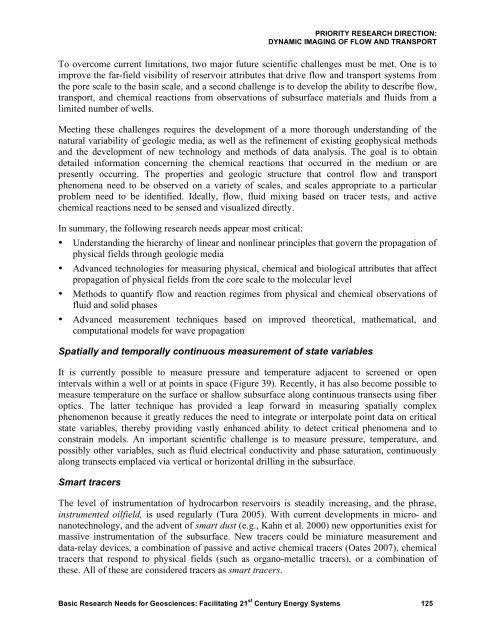Basic Research Needs for Geosciences - Energetics Meetings and ...
Basic Research Needs for Geosciences - Energetics Meetings and ...
Basic Research Needs for Geosciences - Energetics Meetings and ...
- No tags were found...
You also want an ePaper? Increase the reach of your titles
YUMPU automatically turns print PDFs into web optimized ePapers that Google loves.
PRIORITY RESEARCH DIRECTION:DYNAMIC IMAGING OF FLOW AND TRANSPORTTo overcome current limitations, two major future scientific challenges must be met. One is toimprove the far-field visibility of reservoir attributes that drive flow <strong>and</strong> transport systems fromthe pore scale to the basin scale, <strong>and</strong> a second challenge is to develop the ability to describe flow,transport, <strong>and</strong> chemical reactions from observations of subsurface materials <strong>and</strong> fluids from alimited number of wells.Meeting these challenges requires the development of a more thorough underst<strong>and</strong>ing of thenatural variability of geologic media, as well as the refinement of existing geophysical methods<strong>and</strong> the development of new technology <strong>and</strong> methods of data analysis. The goal is to obtaindetailed in<strong>for</strong>mation concerning the chemical reactions that occurred in the medium or arepresently occurring. The properties <strong>and</strong> geologic structure that control flow <strong>and</strong> transportphenomena need to be observed on a variety of scales, <strong>and</strong> scales appropriate to a particularproblem need to be identified. Ideally, flow, fluid mixing based on tracer tests, <strong>and</strong> activechemical reactions need to be sensed <strong>and</strong> visualized directly.In summary, the following research needs appear most critical:• Underst<strong>and</strong>ing the hierarchy of linear <strong>and</strong> nonlinear principles that govern the propagation ofphysical fields through geologic media• Advanced technologies <strong>for</strong> measuring physical, chemical <strong>and</strong> biological attributes that affectpropagation of physical fields from the core scale to the molecular level• Methods to quantify flow <strong>and</strong> reaction regimes from physical <strong>and</strong> chemical observations offluid <strong>and</strong> solid phases• Advanced measurement techniques based on improved theoretical, mathematical, <strong>and</strong>computational models <strong>for</strong> wave propagationSpatially <strong>and</strong> temporally continuous measurement of state variablesIt is currently possible to measure pressure <strong>and</strong> temperature adjacent to screened or openintervals within a well or at points in space (Figure 39). Recently, it has also become possible tomeasure temperature on the surface or shallow subsurface along continuous transects using fiberoptics. The latter technique has provided a leap <strong>for</strong>ward in measuring spatially complexphenomenon because it greatly reduces the need to integrate or interpolate point data on criticalstate variables, thereby providing vastly enhanced ability to detect critical phenomena <strong>and</strong> toconstrain models. An important scientific challenge is to measure pressure, temperature, <strong>and</strong>possibly other variables, such as fluid electrical conductivity <strong>and</strong> phase saturation, continuouslyalong transects emplaced via vertical or horizontal drilling in the subsurface.Smart tracersThe level of instrumentation of hydrocarbon reservoirs is steadily increasing, <strong>and</strong> the phrase,instrumented oilfield, is used regularly (Tura 2005). With current developments in micro- <strong>and</strong>nanotechnology, <strong>and</strong> the advent of smart dust (e.g., Kahn et al. 2000) new opportunities exist <strong>for</strong>massive instrumentation of the subsurface. New tracers could be miniature measurement <strong>and</strong>data-relay devices, a combination of passive <strong>and</strong> active chemical tracers (Oates 2007), chemicaltracers that respond to physical fields (such as organo-metallic tracers), or a combination ofthese. All of these are considered tracers as smart tracers.<strong>Basic</strong> <strong>Research</strong> <strong>Needs</strong> <strong>for</strong> <strong>Geosciences</strong>: Facilitating 21 st Century Energy Systems 125
















